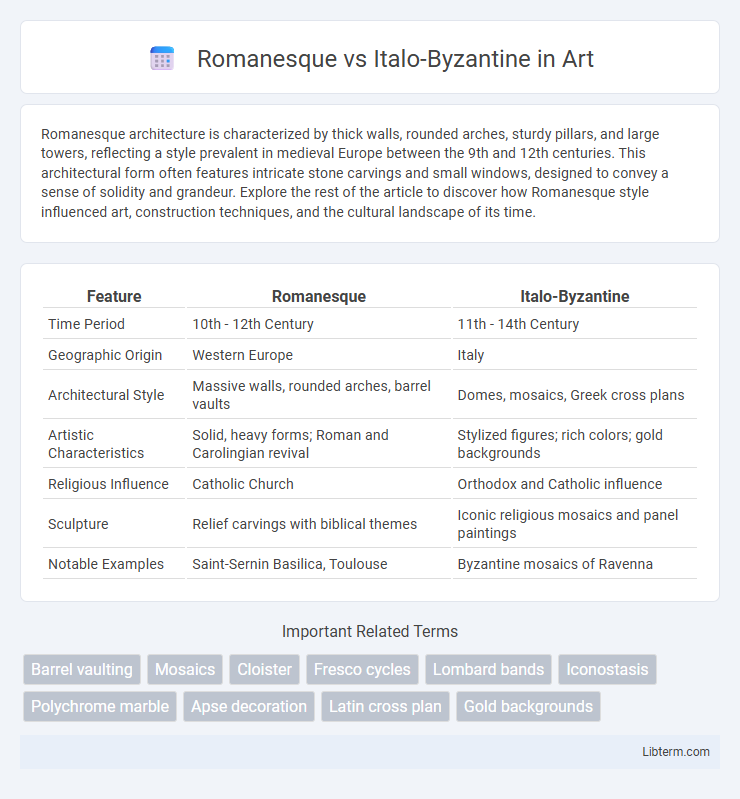Romanesque architecture is characterized by thick walls, rounded arches, sturdy pillars, and large towers, reflecting a style prevalent in medieval Europe between the 9th and 12th centuries. This architectural form often features intricate stone carvings and small windows, designed to convey a sense of solidity and grandeur. Explore the rest of the article to discover how Romanesque style influenced art, construction techniques, and the cultural landscape of its time.
Table of Comparison
| Feature | Romanesque | Italo-Byzantine |
|---|---|---|
| Time Period | 10th - 12th Century | 11th - 14th Century |
| Geographic Origin | Western Europe | Italy |
| Architectural Style | Massive walls, rounded arches, barrel vaults | Domes, mosaics, Greek cross plans |
| Artistic Characteristics | Solid, heavy forms; Roman and Carolingian revival | Stylized figures; rich colors; gold backgrounds |
| Religious Influence | Catholic Church | Orthodox and Catholic influence |
| Sculpture | Relief carvings with biblical themes | Iconic religious mosaics and panel paintings |
| Notable Examples | Saint-Sernin Basilica, Toulouse | Byzantine mosaics of Ravenna |
Origins and Historical Context
Romanesque architecture emerged in Western Europe during the 11th and 12th centuries, rooted in the revival of Roman engineering and early Christian basilicas, thriving amid the feudal system and monastic expansion. Italo-Byzantine art, originating from the Byzantine Empire's influence on Italy between the 6th and 14th centuries, reflects the fusion of Eastern Orthodox iconography with Italian artistic traditions, driven by trade and political ties with Constantinople. Both styles represent distinct cultural exchanges: Romanesque highlights Western medieval consolidation, while Italo-Byzantine embodies the cross-cultural synthesis of Eastern and Western Mediterranean worlds.
Key Architectural Features
Romanesque architecture is characterized by thick walls, rounded arches, sturdy piers, large towers, and decorative arcading, emphasizing solidity and strength in its structures. Italo-Byzantine architecture incorporates extensive use of mosaics, domes with pendentives, and intricate mosaical ornamentation, blending Western and Eastern Christian design influences. Key differences include Romanesque's heavy stone construction versus Italo-Byzantine's emphasis on ornamental surface decoration and centralized, often domed plans.
Influences and Inspirations
Romanesque architecture draws heavily from Roman engineering principles, incorporating rounded arches, massive stone walls, and barrel vaults inspired by ancient Roman structures. Italo-Byzantine style combines Byzantine artistic elements with Italian traditions, featuring intricate mosaics, decorative iconography, and centrally planned church layouts influenced by Eastern Orthodox designs. Both styles reflect cultural exchanges across Europe and the Mediterranean, showcasing a fusion of classical Roman, Byzantine, and local medieval artistic trends.
Structural Techniques
Romanesque architecture features thick walls, rounded arches, and barrel vaults, emphasizing massive stone construction for stability and durability. Italo-Byzantine style incorporates extensive use of domes, pendentives, and intricate mosaic decorations, blending Eastern Byzantine structural innovations with Italian architectural traditions. The contrasting use of heavy stone masonry in Romanesque and the complex, centralized dome structures in Italo-Byzantine highlight distinct approaches to load distribution and spatial design.
Decorative Elements
Romanesque decorative elements feature rounded arches, thick walls, and extensive use of sculptural reliefs with biblical themes, often emphasizing symmetry and geometric patterns. Italo-Byzantine decoration is characterized by intricate mosaics with gold backgrounds, stylized figures, and rich iconographic symbolism, reflecting Eastern Orthodox influences. Both styles incorporate religious motifs but differ in material and technique, with Romanesque favoring stone carvings and Italo-Byzantine emphasizing mosaic artistry.
Iconography and Symbolism
Romanesque iconography emphasizes robust, expressive figures and vivid biblical narratives, often rendered in frescoes and illuminated manuscripts to convey moral lessons and spiritual authority. In contrast, Italo-Byzantine iconography features stylized, frontal figures with elongated proportions and gold backgrounds, symbolizing divine light and the transcendence of the sacred realm. Symbolism in Romanesque art focuses on the struggle between good and evil and the journey to salvation, while Italo-Byzantine symbolism highlights eternal divinity and the unchanging nature of spiritual truths.
Regional Variations
Romanesque architecture, prevalent across Western Europe from the 10th to 12th centuries, features thick walls, rounded arches, and sturdy piers, with regional variations evident in material use and decorative motifs such as the heavy stonework in France and the brickwork common in Lombardy. Italo-Byzantine style, dominant in Italy from the 11th to 13th centuries, exhibits extensive use of mosaics, gold backgrounds, and intricate iconography reflecting Byzantine influence, particularly prominent in Venice and Sicily where Eastern and Western artistic traditions merge. Regional distinctions are marked by Romanesque's robust, fortress-like churches contrasting with Italo-Byzantine's ornate, spiritually symbolic interiors designed to evoke the divine presence.
Notable Examples and Landmarks
Notable Romanesque landmarks include the Abbey of Cluny in France, Durham Cathedral in England, and Speyer Cathedral in Germany, showcasing massive stone walls, rounded arches, and sturdy piers. Key Italo-Byzantine examples feature the Basilica of San Vitale in Ravenna and the Cappella Palatina in Palermo, characterized by intricate mosaics, gold backgrounds, and Greek-cross plans reflecting Eastern influence. These landmarks highlight Romanesque emphasis on structural solidity versus Italo-Byzantine focus on ornate decoration and spiritual symbolism.
Legacy and Impact on Later Styles
Romanesque architecture's legacy lies in its massive stone construction, rounded arches, and sturdy piers, which influenced the development of Gothic architecture with innovations like pointed arches and ribbed vaults. Italo-Byzantine style contributed richly to the visual arts, especially mosaic decoration and iconography, shaping Renaissance artists' focus on religious symbolism and intricate imagery. Both styles profoundly impacted medieval European art and architecture, setting foundational elements that evolved into diverse regional designs in the later Middle Ages and beyond.
Distinguishing Romanesque from Italo-Byzantine
Romanesque architecture features massive stone walls, rounded arches, and small windows creating a fortress-like appearance, while Italo-Byzantine style integrates lavish mosaics, domes, and intricate iconography influenced by Eastern traditions. The Romanesque emphasis on structural solidity contrasts with the Italo-Byzantine focus on decorative surface and spiritual symbolism. Identifying Romanesque buildings involves looking for barrel vaults and thick piers, whereas Italo-Byzantine works often showcase gold backgrounds and stylized figures in religious art.
Romanesque Infographic

 libterm.com
libterm.com